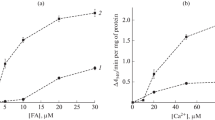Abstract
The time course of hydrolysis of a mixed phospholipid substrate containing bovine liver 1,2-diacyl-sn-glycero-3-phosphocholine (PC) and 1,2-diacyl-sn-glycero-3-phosphoethanolamine (PE) catalyzed byCrotalus adamanteus phospholipase A2 was measured before and after peroxidation of the lipid substrate. The rate of hydrolysis was increased after peroxidation by an iron/adenosine diphosphate (ADP) system; the presence of iron/ADP in the assay had a minimal inhibitory effect. The rate of lipid hydrolysis was also increased after the substrate was peroxidized by heat and O2. Similarly, peroxidation increased the rate of hydrolysis of soy PC liposomes that did not contain PE. In order to minimize interfacial factors that may result in an increase in rate, the lipids were solubilized in Triton X-100. In mixtures of Triton with soy PC in the absence of PE, peroxidation dramatically increased the rate of lipid hydrolysis. In addition, the rate of hydrolysis of the unoxidizable lipid 1-palmitoyl-2-[1-14C]oleoyl PC incorporated into PC/PE liposomes was unaffected by peroxidation of the host lipid. These data are consistent with the notions that the increase in rate of hydrolysis of peroxidized PC substrates catalyzed by phospholipase A2 is due largely to a preference for peroxidized phospholipid molecules as substrates and that peroxidation of host lipid does not significantly increase the rate of hydrolysis of nonoxidized lipids.
Similar content being viewed by others
Abbreviations
- ADP:
-
adenosine diphosphate
- LDL:
-
low-density lipoproteins
- PC:
-
1,2-diacyl-sn-glycero-3-phosphocholine
- PE:
-
1,2-diacyl-sn-glycero-3-phosphoethanolamine
- TBARS:
-
thiobarbituric acid reactive substances
References
Chien, K.R., Pfau, R.G., and Farber, J.L. (1979)Am. J. Pathol. 97, 505–530.
Jackson, M.J., Jones, D.A., and Harris, E.J. (1984)Biosci, Rep. 4, 581–587.
Steinbrecher, U.P., Parthasarathy, S., Leake, D.S., Witztum, J.L., and Steinberg, D. (1984)Proc. Natl. Acad. Sci. USA 83, 3883–3887.
Chan, P.H., Yurko, M., and Fishman, R.A. (1982)J. Neurochem. 38, 525–531.
Katz, A.M., and Messineo, F.C. (1981)Circ. Res. 48, 1–16.
Otani, H., Prasad, M.R., Jones, R.M., and Das, D.K. (1989)Am. J. Physiol., 257, H252-H258.
Hochmann, Y. (1981)J. Biol. Chem. 256, 4783–4788.
Lawrence, A.J., Morrel, G.R., and Steele, J. (1974)Eur. J. Biochem. 48, 277–286.
Ngwenya, B.Z., and Yamamoto, N. (1985)Biochim Biophys. Acta 839, 9–15.
Au, A.M., Chan, P.H., and Fishman, R.A. (1985)J. Cell. Biochem. 27, 449–453.
Weglicki, W.B., Dickens, B.F., and Mak, I.T. (1984)Biochem. Biophys. Res. Commun. 124, 229–235.
Yasuda, M., and Fujita, T. (1977)Japan J. Pharmacol. 27, 429–435.
Borowitz, S.M., and Montgomery, C. (1989)Biochem. Biophys. Res. Commun. 158, 1021–1028.
Sevanian, A., and Kim, E. (1985)J. Free Radicals Biol. Med. 1 263–271.
Sevanian, A., and McLeod, L.L. (1987)Lipids 22, 627–636.
van Kuijk, F.J.G.M., Sevanian, A., Handelman, G.J., and Dratz, E.A. (1987)Trends Biochem. Sci. 12, 31–34.
van Kuijk, F.J., Handelman, G.J., and Dratz, E.A. (1985)J. Free Radicals Biol. Med. 1, 421–427.
Tan, K.H., Meyer, D.J., Belin, J., and Ketterer, B. (1984)Biochem. J. 220, 243–252.
Sevanian, A., Wratten, M.L., McLeod, L.L., and Kim, E. (1988)Biochim. Biophys. Acta 961, 316–327.
Apitz-Castro, R., Jain, M.K., and de Haas, G.H. (1982)Biochim. Biophys. Acta 688, 349–356.
McLean, L.R., Demel, R.A., Socorro, L., Shinomiya, M., and Jackson, R.L. (1986)Meth. Enzymol. 129, 738–763.
Roberts, M.F., Adamich, M., Robson, R.J., and Dennis, E.A. (1979).Biochemistry, 18, 3301–3307.
Sevanian, A., Stein, R.A., and Mead, J.F. (1981)Lipids 16, 781–789.
Adamich, M., Roberts, M.F., and Dennis, E.A. (1979)Biochemistry 18, 3308–3314.
Sparrow, C.P., Parthasarathy, S., and Steinberg, D. (1988)J. Lipid Res. 29, 745–753.
McLean, L.R., and Hagaman, K.A. (1989)Biochemistry, 28, 321–327.
Author information
Authors and Affiliations
About this article
Cite this article
McLean, L.R., Hagaman, K.A. & Davidson, W.S. Role of lipid structure in the activation of phospholipase A2 by peroxidized phospholipids. Lipids 28, 505–509 (1993). https://doi.org/10.1007/BF02536081
Received:
Revised:
Accepted:
Issue Date:
DOI: https://doi.org/10.1007/BF02536081




